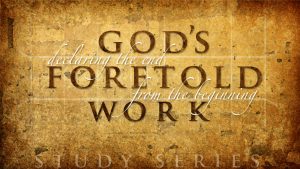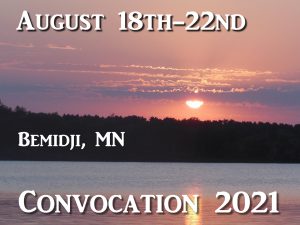Hello Reggie, thank you for all your answers on the current and coming situation of Israel. Please, let me know why amilliennialists are denying the future of Israel and the church and why they say .. the prophecy of Daniel —-it all has been already its past not future!??
How we read Daniel and Revelation is first an issue of whether we can trust what Luther called, “the priesthood of every believer,” or whether we can only safely follow the tradition of interpretation that has come down to us through many of the church’s theological heroes, such as the famed magisterial Reformers, Luther, Calvin, and Zwingli, and their vast theological progeny, as also the popes and bishops of the church of Rome. For the larger part, all have been Augustinian in their interpretation of Daniel and the Apocalypse. This is why amillennialism has dominated most of Protestant and nearly all Roman Catholic eschatology. It is well known that St. Augustine of Hippo is the father of the a-millennial interpretation of the thousand years (i.e., that the church is the kingdom of God on earth and the millennium is symbolic of the church age).
Augustinian denial of a future millennium is not the only system of interpretation that denies the literal interpretation of the many prophecies that depict the post-tribulational salvation of a surviving remnant of the Jewish people and the restoration of the nation as a distinctly “Jewish” nation (Dan 2:44). Simply put, if there is no millennium, there can be no literal fulfillment of the vast amount of prophecy that depicts a glorious future for benighted and beleaguered Israel after the unequaled tribulation at the coming day of the Lord, which the New Testament equates with the time of Christ’s return.
Exegetically, it all depends on where you locate the unequaled tribulation of Mt 24:21. If Mt 24:21 is the same event described in Dan 12:1, then not only are the righteous raised at Christ’s post-tribulational return, but Daniel’s people (the Jews) are also delivered at the same time (Dan 12:1, 2). Therefore any past tribulation that did not end in the simultaneous events of the return of Christ, the resurrection of the righteous, and the deliverance of Daniel’s people cannot be “the great tribulation” described in Jer 30:7; Dan 12:1, and Mt 24:21. It is that simple. .
Augustinian amillennialism teaches that the first resurrection is either the spiritual new birth or the reign of the martyrs from heaven. But according to Rev 6:10-12, the first resurrection must await the final persecution and the destruction of the beast. In fact, the first resurrection receives its very designation as “first” in direct connection with the tribulation martyrs that were beheaded by the “last” beast (Rev 20:4), and it is clear that this beast is not destroyed until the Lord’s return (Dan 7:11 with Rev 19:20, also 2Thes 2:8) at “the great day of God almighty” (Rev 16:13-16).
Therefore, one cannot consistently put the first resurrection in the past without putting the destruction of the Antichrist in the past. The same position that requires the great tribulation to be in the past, often teaches that the beast of Revelation was Nero. This view is called preterism. Once one starts down that path, there’s no stopping till the return of Christ, the Antichrist, and sometimes even the resurrection of the dead in Dan 12:2 are all put in the past. Amillennialists, which are not all preterists, typically put the tribulation in the past. Not all put the Antichrist in the past, but all put the first resurrection in the past.
The fundamental error of amillennialism is its blindness concerning the mystery of Christ in its relation to the tribulation. The basic apologetic of the New Testament in its Jewish milieu was to show the prophetic necessity that the Messiah should appear, be cut off (Isa 53:8; Dan 9:26) and raised (Isa 53:12) BEFORE the tribulation, also called Zion’s travail, or the time of Jacob’s trouble (Isa 66:7-8; Mic 5:1-4; Rev 12:5-6, 12-14). According to a number of New Testament passages, the day of the Lord, also called the day of God, comes immediately after that great tribulation (compare Joel 2:31 with Mt 24:29; also Ezek 39:8 with Rev 16:14-17). The only day of the Lord that the New Testament knows comes AFTER the darkness that comes immediately AFTER the tribulation of those days (compare Mt 24:29; Acts 2:20).
In both testaments, the day of the Lord is the great dividing point between this age and the age to come. Some of the regenerative powers of that coming day have already broken into (invaded) the present age through the Holy Spirit and the revelation of the mystery of the gospel. But this does nothing to cancel or change what remains to be “literally” fulfilled for Israel and the nations at the still future, post-tribulational, day of the Lord (Acts 3:18-21; 1Thes 5:2; 2Pet 3:10, 12; Rev 16:14-15). This is what amillennialism, and all replacement systems, are forced to deny.
Amillennialists want to say that “ALL” of the glorious promises that should come after the day of the Lord have come already through the Spirit, and that’s it. Nothing else is to be expected other than the new heavens and earth of the final perfection. See how it works? Reformed theology rightly appropriates the fulfillment of the everlasting covenant promised to Israel to the church. The scriptures themselves apply Israel’s covenants and promises to the church, particularly since there are no others. We’ve been “grafted in among THEM” (Ro 11:17).
Amillennialists are quite right to be suspicious of Dispensationalism’s novel doctrine that the church ends at the rapture. Anyone born of the Spirit is a member of Christ’s body, regardless of age or dispensation. But the fundamental error of amillennialism is its failure to see the mystery of Christ’s twofold coming, not as changing what remains to be fulfilled to Israel in the still future day of the Lord, but as bringing the powers of that coming day into the present through the revelation of the gospel.
The revelation of the mystery of the gospel brought to light both a pre and a post tribulational coming of the Messiah, the latter well known and the former unknown until the appointed time of revelation. Whereas it was ordained that the world of the gentiles should receive the gospel through Israel’s fall, this did nothing to cancel the future covenant hope that remains to be established with the nation of the Jews on the “other side” of the tribulation, at the still future day of the Lord.
The post-tribulational salvation of Israel is a constant theme of the prophets. The salvation of that coming day has indeed appeared in unexpected advance through the mystery of a twice coming Messiah. But the mystery does nothing to change what will yet surely follow the tribulation according to the foreview of both testaments (Lk 21:24; Acts 3:21; Ro 11:25). This is the amillennial fallacy. By recognizing the presence of some aspects of that future day through the Spirit and the gospel, it empties the day of the Lord of all its literal content, except, of course, the return of Christ and the immediate destruction of this present earth and creation of the new. Since there is no future for the Jew beyond this age, there is no need for a millennial kingdom on earth. That’s the logic.
Amillennial interpretation rightly applies the “already” of prophetic fulfillment that has come to the church as first-fruits, but denies the “not yet” of future post-tribulational fulfillment to the Jewish natural branches. But for Paul, the covenant is not complete apart from the re-engraftment of the “natural branches” and the full coming in of all Israel as a completely regenerate nation (Isa 54:13; 60:21; 59:21; Jer 31:24; 32:40), born in one day (Isa 66:9; Ezek 39:22-29; Zech 3:9). Their recovery to covenant favor is not a mere addendum. It is a covenant necessity! It is a divine necessity! It is the “without which not” of Christ’s return and the ‘complete’ fulfillment of ‘all’ the provisions and promises of the covenant (“This is My covenant unto THEM;” Ro 11:25-27). God’s very name and glory is at stake (Ezek 36:22, 32).
One is hard pressed to ignore that Jesus’ very language in Mt 24:21 has obvious direct reference to Dan 12:1. The language is virtually identical. That is no accident. Replacement systems are forced to ignore or play this down. It is a great problem for them. Observe: Daniel, being informed of Jeremiah’s prophecy (Dan 9:2), shows that the time of “Jacob’s trouble” (Jer 30:7) comes at the end of an extended time of exile, the seventy sevens (490 years) of Dan 9:24.
Daniel is interested to show an explanation that will help the dejected exiles to understand why the redemption had been delayed. The returning exiles did not find upon their return the beginnings of a glorious golden new age, as many had been led to expect by the great flourishes of prophetic promise connected with the return. Rather, they met with very disappointing circumstances that fell far short of their ‘great expectations’ engendered by the promises of return that were known to them from the eighth century prophets of the pre-exilic period. At best, it was “a day of small things” (Ezr 3:12; Zech 4:10). Hence, Daniel’s prophecy brought the consolation of a reasonable explanation for ‘the dissonance of delay.’ Daniel’s prophecy would show that the final redemption and the resurrection is not destined to come until AFTER an extended exile of seventy more sevens of years.
Furthermore, Daniel sees the unequaled distress described in Jeremiah’s prophecy of return (Jer 30:6-7) as coming at the last half of the last week, i.e., the last 3 1/2 years (compare Dan 9:27; 11:31 with Dan 12:1-2, 7, 11). It is after the final and unequaled trouble that Daniel’s people (the saved among them) will be delivered and the righteous raised from the dust of the earth (Dan 12:1-2). What could be plainer? The undeniable similarity of language with Jesus’ reference to the great tribulation in Mt 24:21 should make the futurity of the tribulation, and the post-tribulational “first resurrection” of the martyred saints, completely beyond dispute.
Of course, this view requires us to recognize a ‘gap’ between the 69th and 70th weeks of Daniel. This is difficult, but it is not out of keeping with the mystery of Christ’s two comings. Furthermore, if we are not to suppose that prophecy has failed, such a gap must be recognized in many prophecies where the near and partial fulfillment is blended with the distant and complete fulfillment. In many places Christ’s first and second comings are combined in the same prophecy without clear distinction. That distinction waited the time of the revelation of the mystery of the gospel (Acts 3:18-21; Ro 16:25-26; Eph 6:19; 1Pet 1:11).
Although a great mystery, belonging to the one time hidden (Ro 16:25; 1Cor 2:7; Eph 3:9; 6:19; Col 1:26), albeit completely foretold (Lk 24:25-27; Acts 3:18-21; 26:22; Ro 16:26; 1Pet 1:11), Old Testament mystery of Christ, a great parenthesis between the 69th and 70th weeks of Daniel is an exegetical necessity.
If the larger context of the book is to be given first priority in deciding the author’s meaning, there can be no doubt that the “prince” that stops the sacrifice in Dan 9:27 is NOT “Messiah the prince” but “the prince that shall come” (Dan 9:26-27). This is clear; because in every other reference in Daniel, the sacrifice is always stopped by the one who exalts himself (see Dan 8:11; 11:31-37; 12:11).
According to Paul, this is the man who finishes the mystery of iniquity that holds back the return of Christ (2Thes 2:7-8). He is the one who sits in the temple proclaiming himself God (compare Dan 11:36-37 with 2Thes 2:4-8). Paul’s man of sin, and Daniel’s self exalting ‘little horn’ and ‘king of fierce countenance’ is manifestly the final beast who treads down Jerusalem and persecutes the saints for the last 3 1/2 years of unequaled trouble (Dan 7:21-25; 9:27; 12:7, 11; Rev 11:2; 13:5).
Amillennialism tends to be notoriously inconsistent in their doctrine of a future Antichrist. They do not typically recognize that Christ’s return awaits the final revelation of the mystery of iniquity (2Thes 2:7), not merely in some ubiquitous system or spirit, but in a very definitely described individual whom Daniel calls the self exalting, ‘willful king’ (Dan 11:36-37), and whom Paul calls, “the man of sin” (2Thes 2:3-4, 7-8). When Paul is writing to the Thessalonians, this figure has not yet come, but must come and be on the scene at the time of Christ’s return (2Thes 2:7-8; Rev 11:2; 13:5).
Though referred to by many names throughout scripture, and pre-typified by all the great God opposing gentile kingdoms of antiquity, this is the personal “king” spoken of all throughout Daniel’s prophecy (Dan 8:23; 11:21; 11:36). A comparison of Dan 11:36 with 2Thes 2:4 will show beyond reasonable dispute that Paul has this particular king in view.
Throughout Daniel’s prophecy, this king is shown making definite geographical movements and military conquests (Dan 8:9; 11:23-45). He performs very specific acts of violence against Jerusalem and the worship of the Jews. All the prophets foretold of this one whom God would bring against Israel in the latter days (Ezek 38:17). According to both Daniel and Jesus, the desolating sacrilege starts the time of Jerusalem’s final desolation, which is the last three and one half years of unequaled tribulation (Dan 7:21, 25; 9:24; 11:31; 12:7, 11; Mt 24:15-16, 21; Rev 11:2; 12:6, 14; 13:5).
You may remember that I wrote on this in a previous email where I showed the exegetical impossibility of putting the ten kings that are allied with the final beast back in the time of Roman Empire. Rev 17:12 makes such a proposal seem forced to say the least (see the article, Dan 2:44 – The Kingdom Shall Not Be Left to Another People). But this is what amillennial interpreters are forced to do in order to keep the kingdom of Dan 2:44 and the first resurrection of Rev 20:4 in the first century. But what about a last persecution by the beast? What about the ten kings who are contemporaries with a beast who is manifestly the willful king of Dan 11:36, whom Paul says has not yet been revealed (2Thes 2:3-6), but who is present to be destroyed at Christ’s return? (2Thes 2:7-8). These are just some of the many kinds of things that must be ignored in order to dismiss a future millennium and to equate the future “blessed hope” of the church, not with the first resurrection of Rev 20:4, but with the second resurrection of Rev 20:12-13. Go figure!
How can such plain language be overlooked? Why? What culpability before God is implicit in such handling of scripture? What does this portend for millions in the church who have inherited this teaching from their mentors and leaders through centuries of ‘church tradition’? There is no reason why any of these plain statements of revealed truth should be spiritualized or “re-interpreted.” It should be clear that Daniel’s prophecy was manifestly read as both literal and future by the Lord and His first century ‘Jewish’, apocalyptic minded, apostles.
Finally, if a future tribulation and Antichrist is indeed ahead for the church and Israel, and if the knowledge of these things are indeed critical for the church’s preparation, as well as marking the time of Satan’s eviction from heaven and the start of the tribulation (compare Dan 12:1 with Rev 12:7-14), then it seems that these things greatly threaten Satan’s place. He’s in no hurry for this time to come, since it will mean he has lost his place and his time is short (Rev 12:12). This helps explain why things so otherwise plain and accessible should be so strangely hidden and opposed.
These be the days, Reggie



